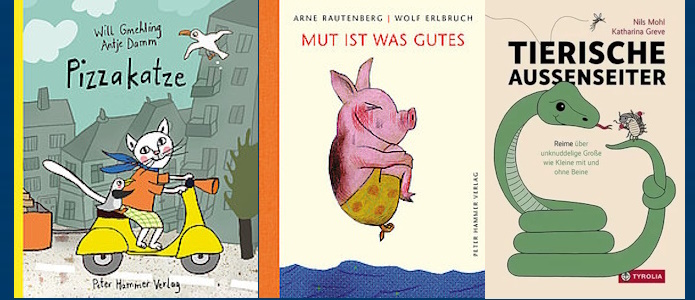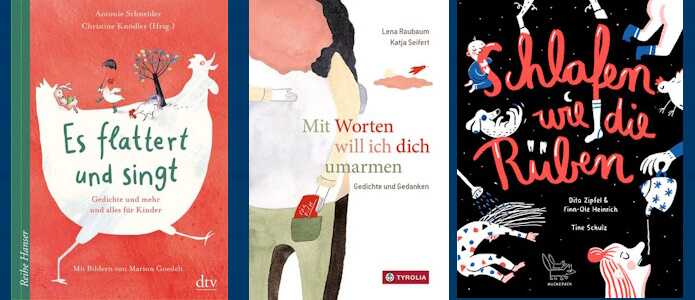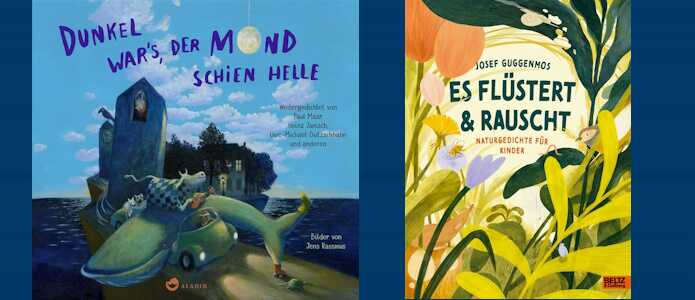Bookmarket
HaiKuh

Poetry Recommendations for Children
by Dr. Ines Galling
On World Poetry Day, March 21, 2024, the “HaiKuh” for children stepped onto the literary stage: the sassy heraldic animal serves as mascot of the poetry recommendations list for children (LYEfK), which was launched last year. The LYEfK is now part of the poetry recommendations list for adults (LYE), which has been around for over ten years and is published annually. The LYE’s cooperation partners are the German Academy for Language and Poetry (DASD), the Poetry Cabinet Foundation and the House of Poetry. The International Youth Library Foundation (IJB) in Munich has also recently joined the LYE for children’s poetry. IJB is the world’s largest specialist library for children’s and young adult literature with a wide-ranging program of events, education and research.
The first eleven LYEfK titles were published on March 21, 2024, in a brochure and on www.lyrik-empfehlungen.de together with the most recent list of selected poems for “grown-ups”. The members of a poetry-loving panel —consisting of writers, illustrators, critics, university lecturers and the winners of the lyrix competition for young poetry— presented their personal favorites in attractively succinct, pithy texts. Both original editions and translations are taken into account for the selection, and the recommended titles are primarily aimed at children between the ages of three and eleven.

Another important aspect of the LYEfK is its extensive educational and event programming: authors or qualified literary educators offer readings and workshops in both small and large formats at kindergartens and schools, as well as at literature festivals and in literature houses. In this round alone, the LYEfK has organized a total of over 50 different formats on the books they have selected – in every German federal state as well as in Austria and Switzerland.
Moreover, there are so-called “handouts” for stakeholders and multipliers. Einfach lyrisch! (Cf. Simply poetic) offers educators methods and materials for introducing school classes to the recommended volumes: in it they can find a wide variety of exercises-, production-oriented and performative impulses, which emphasize the tonal dimensions of the poems as well as the sensory experience and the interplay of language, body and movement. These original and playful-creative approaches are fun and promote a variety of skills en passant. The handouts can be downloaded free of charge from www.lyrik-empfehlungen.de and also offer interesting suggestions for GFL lessons.
The LYEfK-Selections from 2024
The eleven books cover a wide spectrum and represent current trends in children’s poetry, while also opening our eyes to something quite unusual. The eleven books include eight original German-language (see references below) volumes – which include older texts that have been rediscovered, as well as new discoveries, classics and conceptually surprising works. The themes range from finding oneself in the world to children’s everyday lives—their thoughts and feelings, through to nature and animals, which has been a perennial favorite in children’s poetry for many years.
All of the books exhibit a profound trust in language – the poem by Austrian Lena Raubaum entitled “Was Worte alles können” (What words can do) is pars pro toto in this regard. Trust in language also goes hand in hand with a delight “in” language: in nonsense, in linguistic and phonetic wit, sounds, assonances and rhymes. The tone of the books is often funny and witty, sometimes pensive and melancholy, along with a good portion of surprising punchlines and aha moments. All the books are illustrated, which adds further levels of interaction and opens a space for further interpretation.

Finn-Ole Heinrichs, Dita Zipfels and Tine Schulz's Schlafen wie die Rüben (Sleep like the turnips) and Uwe-Michael Gutzschhahn's Dunkel war’s der Mond schien helle (It was dark and the moon shone brightly) join the (children’s) lyrical tradition: In the “Turnip”, rhymes about falling asleep and the classic subject of “going to bed” anarchically go against the grain, as wild, lustful and exuberant verses and images fracture the clearly composed choreography. On the initiative of children’s poetry jack-of-all-trades Uwe-Michael Gutzschhahn, ten poets including himself have continued the anonymous nonsense poem Dunkel war's der Mond schien helle. Nobody (apart from U.M. Gutzschhahn) knows which of the 34 verses were written by whom. This unusual project was illustrated by Jens Rassmus, who masterfully depicts the lyrically evoked paradoxes on each double-sided page. Josef Guggenmos has inscribed himself into the world of nature poetry: The poet, who died in 2003, took long walks every day through fields and meadows in his native Allgäu and listened to birds and insects. His connection with nature shaped his self-image and was an important source of inspiration for his poetic work: In just a few lines, he condenses precise observations and sensual experiences, revealing the essential aspects of existence which often carries with it a metaphysical dimension. His connection to nature shaped his self-image and was an important source of inspiration for his poetic work: In the volume Es flüstert & rauscht (It’s whispering and rushing), various artists have illustrated his poems: sometimes they are full-page, delicate watercolor, sometimes employing brightly colored pencil strokes, sometimes in comic form – always surprising and never boring.
Never boring— this best describes today’s German-language poetry scene for children, because it is more diverse than it has ever been before. The desire for experimentation and poetic play, for language and for “turning old into new” is palpable. This explicitly refers not only to the textual work but also the illustrations that accompany the poems: fresh, modern illustrations, comic or caricature, give poems an immediately recognizable casual touch – the desire for poetry often comes all by itself. The boundaries between individual genres has grown permeable, which is a plus for children’s poetry, for we see that there is more poetry in the world than we might initially notice. One indicator of this diversity has to do with the fact that established children’s poetry publishers, such as Peter Hammer or Tyrolia, are not the only books that have been nominated for the LYEfK. On closer inspection, we can discover poetry in wildly unexpected places. This can only mean one thing: The poetization of the world is progressing. And that’s a good thing.
Dr. Ines Galling is an editor for German-language and Scandinavian children’s and young adult literature at the International Youth Library Foundation. Her work includes conceiving and organizing events, readings and exhibitions. She also is in charge of collecting and expanding the White Ravens archive, which involves a bit of instagram work. She also coordinates poetry recommendations for children and writes articles and reviews for various outlets, including 1001 Buch, JuLit and Dein Spiegel.
References:
- Gmehling, Will: Pizzakatze. Illustriert von Antje Damm. Wuppertal: Peter Hammer 2023.
- Guggenmos, Josef: Es flüstert & rauscht. Naturgedichte für Kinder. Hrsg. von Stefanie Schweizer. Illustriert von Pia Valär, Max Fiedler, Jonas Lauenströer u.a. Nachwort von Arne Rautenberg. Weinheim: Beltz & Gelberg 2022.
- Gutzschhahn, Uwe-Michael (Hrsg.): Dunkel war’s, der Mond schien helle. Weitergedichtet von Paul Maar, Heinz Janisch, Uwe-Michael Gutzschhahn u.a. Illustriert von Jens Rassmus. Stuttgart: Thienemann-Esslinger 2023.
- Heinrich, Finn-Ole / Zipfel, Dita: Schlafen wie die Rüben. Illustriert von Tine Schulz. Hamburg: Huckepack im Mairisch Verlag 2021.
- Mohl, Nils: Tierische Außenseiter. Reime über unknuddelige Große wie Kleine mit und ohne Beine. Illustriert von Katharina Greve. Innsbruck: Tyrolia 2023
- Raubaum, Lena: Mit Worten will ich dich umarmen. Illustriert von Katja Seifert. Innsbruck: Tyrolia 2021.
- Rautenberg, Arne: Mut ist was Gutes. Illustriert von Wolf Erlbruch. Wuppertal: Peter Hammer Verlag 2023.
- Schneider, Antonie: Es flattert und singt. Gedichte und mehr und alles für Kinder. Illustriert von Marion Goedelt. Hrsg. von Christine Knödler. München: dtv 2020.
Translated by Zaia Alexander
Copyright: © 2025 Litrix.de